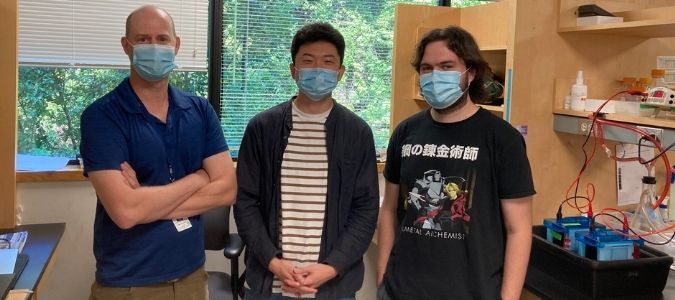Type 2 Diabetes Research in the Guertin Lab Tracked and Discovered New Functions of Glucose in Brown Fat
Date Posted: Thursday, September 09, 2021
Obesity is the leading risk factor for type 2 diabetes. One of the research goals of David Guertin, PhD at UMass Chan Medical School is to understand adipose (fat) tissue and the role it plays in metabolism. Brown adipose tissue (BAT), commonly referred to as brown fat, is a type of body fat that is activated in cold conditions. Its primary function is to convert the energy from fat storage and food into heat that helps maintain body temperature in cold conditions. It’s known that active brown fat consumes and utilizes a significant amount of glucose (and other nutrients). This has provoked the exciting idea that triggering brown fat activity with drugs could be a potential therapeutic strategy to treat diabetes, hyperglycemia, obesity, etc. However, until recently, it was unclear how brown fat used the glucose it consumed.
In a new study published in Cell Reports, the Guertin lab learned that BAT uses glucose not only for fuel, but for many other metabolic pathways that support heat production (also called thermogenesis). This was made possible by adapting a new technique and strategy to track how brown fat utilizes individual glucose atoms as it consumes them.
Brown Adipose Tissue (BAT)
We know that newborn babies, small mammals, and hibernators have high levels of brown adipose tissue (BAT) to help protect them against cold; however, its role in adult humans is still being investigated. BAT was first identified in adult humans in 2009 during FDG-PET-CT scans conducted to detect metastatic cancers. The fact that brown fat utilizes a significant amount of glucose was the basis for its detection. However, scientists still don’t understand the biology of how that blood sugar is used.
Glucose Tracking in Brown Fat
Glucose has long been known to provide energy and facilitate heat production (thermogenesis), but this study reveals that it serves other purposes as well.
Su Myung Jung, PhD, and research assistant Will Doxsey led the study in collaboration with Cholsoon Jang's lab at the University of California, Irvine. Doxsey was excited to be on the first team to explore the pathways of glucose, comparing it to being a cartographer for metabolism and creating a map of the unknown. Dr. Jung used the analogy of putting a GPS tracker on the glucose, and they discovered that it traveled more routes than anyone initially thought.
“This is the forefront of understanding how organs use nutrients in vivo in a physiological context,” said Dr. Guertin, a professor in the program in molecular medicine at UMass Chan Medical School. “These techniques have been accomplished in cultured cells for some time, but we’ve now developed the methods to do it in a whole mouse, which is a great model of human brown fat biology.”
The conventional thinking was that BAT took up glucose and other nutrients and immediately burned them to create heat, but they wondered if the glucose might serve different purposes. They indeed uncovered several functions of glucose not previously known to play a role in thermogenesis. They learned that glucose is converted into other molecules that help support the function of brown fat.
“It’s exciting to work on the first team in the world to optimize this tactic to study brown adipose tissue,” said Dr. Jung. “Obtaining the data we were able to collect, plus what we observed, makes this project doubly exciting!”
“It’s the first time it’s been applied on this level to BAT,” added Dr. Guertin. “Combining this technique with our expertise in adipose tissue biology has us excited for future explorations of in vivo brown fat metabolism.”
A Catabolic Cell First Performing Anabolic Metabolism
Metabolism can either be catabolic or anabolic. The significant difference is how the molecules are utilized in the body. Anabolism creates molecules the body needs to function, and it uses energy in the process. Catabolism breaks down complex molecules, releasing energy that the body can use.
Classic thinking was that thermogenic cells use glucose mainly for catabolic purposes, primarily to fuel heat production. This study demonstrates that glucose is also converted into other macromolecules, including lipids, through an anabolic pathway, which are subsequently broken down and utilized as fuel. Why this happens is still unknown.
“We’re now very curious about why that is and plan to explore it further,” said Dr. Guertin. “Interestingly, it is quite similar to the metabolism of many cancer cells.”
Glucose has been shown to produce and burn lipids and other metabolites that are created and used when the body breaks down food or its own tissue, in this case, brown fat. In future experiments, they plan to explore the newly discovered glucose-driven pathways further to understand their roles and importance.
As previously mentioned, cold temperature activates brown fat, but this study showed that both the degree and duration of temperature can affect how glucose is used. It also identified several metabolites that increase in abundance when BAT is activated, leaving more questions unanswered.
What’s Next?
The data produced in this study open the door for numerous future investigations into the role of the newly discovered metabolic pathways in brown fat. “This paper provides a new map of information for scientists worldwide to explore unknown territory that’s ripe for discovery,” said Dr. Guertin. “We’ve also provided the approach and methodology by which to study it.” The Guertin lab will continue to learn more about glucose and other nutrients, as well as how they are utilized by brown fat. Hopefully, scientists can utilize this enhanced understanding of brown fat metabolism to identify strategies for activating the tissue as a means of combating obesity and diabetes.
Su Myung Jung, PhD
 Dr. Jung spent nearly five years as a postdoctoral fellow in the Guertin lab, which the American Diabetes Association funded. He recently accepted a faculty position at his alma mater, Sungkyunkwan University in South Korea, where he earned his undergraduate and PhD degrees in molecular cell biology. With his own independent lab, Dr. Jung looks forward to future collaborations with the Guertin lab studying brown fat metabolism and mTORC2 signaling.
Dr. Jung spent nearly five years as a postdoctoral fellow in the Guertin lab, which the American Diabetes Association funded. He recently accepted a faculty position at his alma mater, Sungkyunkwan University in South Korea, where he earned his undergraduate and PhD degrees in molecular cell biology. With his own independent lab, Dr. Jung looks forward to future collaborations with the Guertin lab studying brown fat metabolism and mTORC2 signaling.
Will Doxsey, Research Assistant
 Will is a research technician who recently graduated from UMass Amherst with his sights set on graduate school. He received high praise from Dr. Guertin, who said, “Will is a gifted young scientist with a bright future in research.” His goal is to have his own independent research lab someday.
Will is a research technician who recently graduated from UMass Amherst with his sights set on graduate school. He received high praise from Dr. Guertin, who said, “Will is a gifted young scientist with a bright future in research.” His goal is to have his own independent research lab someday.
